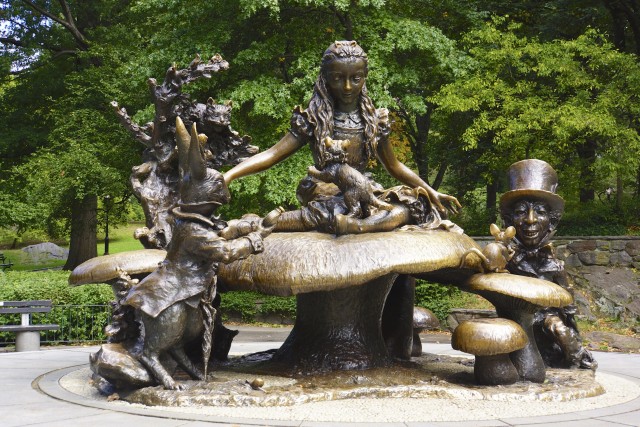
Alice In Wonderland, is an 11 foot bronze statue located in Central Park at East 74th Street. The statue was commissioned by philanthropist George Delacorte for the children of New York. It depicts Alice, sitting on a mushroom along with the Mad Hatter and the White Rabbit. The statue’s glowing bronze patina is a result of the many children who sit and climb on it in enjoyment of its whimsical display of some of Lewis Carroll’s most beloved characters.
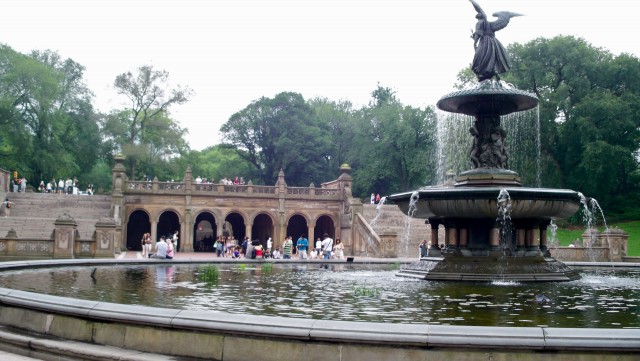
Bethesda Terrace, located in Central Park , is a two level space that overlooks the lake. It includes an elaborately sculpted fountain adorned with a winged, female angel, designed by Emma Stebbins in 1868. Stebbins was the first woman to receive a public art commision in NYC.

The Edith Fabbri House is an Italian Renaissance revival-style townhouse on the Upper East Side. It was designed in 1916, by Grosvenor Atterbury and presently, the building serves a retreat house. The building is L-shaped, consistent with the Italian Renaissance style, and features of a library, a courtyard and a garden. It became a designated NYC landmark in 1974.
—Samantha McKinney
| link | Architecture |
| wiki | Eddit Fabbri |
| sight |
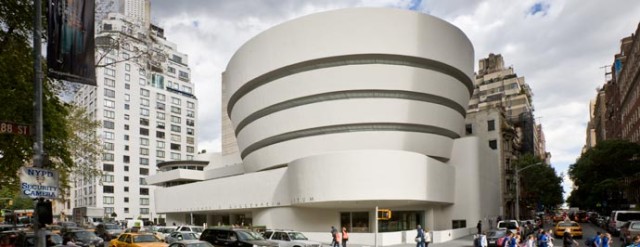
The Guggenheim, located on the Upper East Side neighborhood of Manhattan, contains one of the world’s largest collections of modern and contemporary art. It was founded in 1939 by Solomon R. Guggenheim and moved to its current space, on the Upper East Side, in 1959. It’s long time home was designed by famed architect Frank Lloyd Wright and continues to be one of New York’s most iconic buildings.
—Samantha McKinney
| sight | Bayard Condict Building |
| sight | Cast Iron Facade Mural |
| wiki | Guggenheim Museum |
| link | Museum Information |
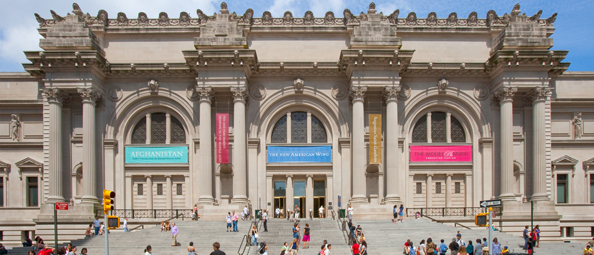
The Met, as it is known to many city dwellers, is the largest art museum in the U.S. It is home to a multitude of pieces ranging from classical antiquity and Islamic art, to modern and contemporary. It first opened it’s doors in the 19th century and continues to be one of the world’s top destinations for museum goers.
—Samantha McKinney
| sight | Loopy Doopy (Blue and Purple) |
| sight | Moonbird |
| link | The Met History |
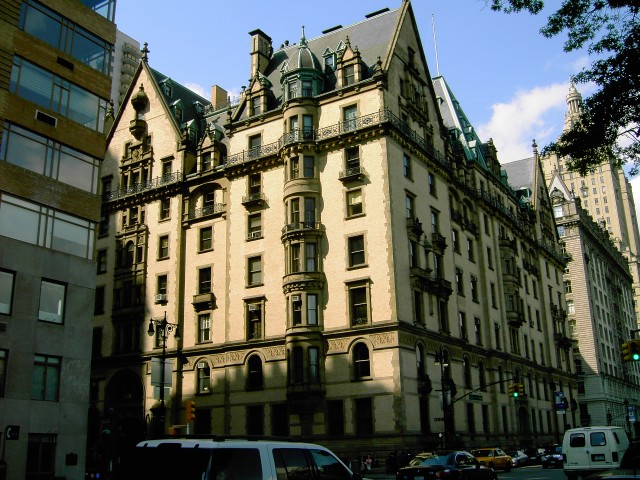
These culturally and historically rich upscale apartments are located on 72nd and Central Park West. Built between 1880 and 1884, the Dakota remains one of Manhattan’s most prestigious residential buildings. The apartments have housed many well known entertainers including actress Judy Garland, composer Leonard Bernstein and John Lennon. Lennon was murdered at the apartment’s south entrance in 1980. The architect, Henry J. Hardenbergh, also designed NYC’s Plaza Hotel.
—Samantha McKinney
| sight | Gapstow Bridge |
| sight | Strawberry Fields |
| wiki | Dakota |
| link | Streeteasy |

Skating on Wollman Rink is a winter tradition for New Yorkers and tourists alike, so many people have tied up their skates for the very first time on this ice. Ice skating is a long-standing and beloved tradition here in Central Park — as old as the Park itself.
The first part of Central Park to open to the public was the Lake, in 1858. Soon after, skaters filled the 59th Street Pond as well. Wollman Rink opened in 1950, a 33,000-square-foot venue built with a gift from Kate Wollman.
| internal | gDoc TBC |
| internal | Central Park info |

Although today the Park’s largest lawn without ballfields features people, it was originally the home to a flock of pure bred sheep from 1864 until 1934. The sheep and shepherd were housed in a fanciful Victorian building nearby, what became the famous Tavern on the Green restaurant in 1934.
The 1858 design competition for Central Park required a parade ground for military drills, and winning landscape architects Frederick Law Olmsted and Calvert Vaux reluctantly included the parade ground in their Greensward plan. The Park’s Commissioners and designers ultimately felt that military use conflicted with their vision of the Park as a quiet escape.
In the 1960s and 70s, Sheep Meadow became the scene for large-scale concerts, the televised landing on the moon, peace rallies and anti-Vietnam War demonstrations. But these events, and the lack of management and maintenance, led to the lawn becoming severely eroded — a virtual dustbowl. In 1980, it was restored and has been maintained by The Central Park Conservancy ever since. The meadow became the Park’s first Quiet Zone, which means it’s the perfect place to relax and unwind. Sheep Meadow attracts thousands of visitors, who gather to sunbathe, picnic, fly kites, and enjoy this pastoral escape, free from the hustle and bustle of New York City, but with one of the best views of Manhattan’s famous skyline.
| internal | gDoc TBC |
| internal | Wikipedia |
| internal | Central Park info |
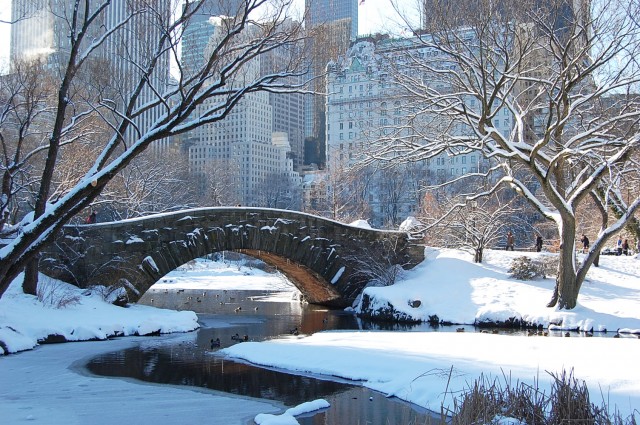
Curving gracefully over the neck of the Pond at 59th Street, Gapstow is one of the iconic bridges of Central Park. It is the second bridge on the site. The first, a much more elaborate wood and iron bridge, designed by Jacob Wrey Mould, deteriorated and was replaced in 1896.
The bridge offers postcard views of the surrounding cityscape. Facing south, you can see the famed Plaza Hotel and distinctive New York skyscrapers rising from above the Park’s trees. Look southward in the winter and you’ll see Wollman Rink’s twirling skaters; in the warmer months you’ll see the colorful amusements of Victorian Gardens.
| internal | gDoc TBC |
| internal | Central Park Conservancy |

The famed Carousel, with its sweet calliope music and 57 magnificent horses, is the fourth to stand in Central Park since 1871. It is one of Central Park’s most popular favorite attractions. It is said that a live mule or a horse, hidden beneath the Carousel platform, powered the original amusement ride from 1873 until 1924. The animals were taught to start and stop when the operator tapped on the floor.
The next two Carousels were destroyed by fire, the first in 1924 and its successor in 1950. Searching for a replacement, the Parks Department discovered the current vintage carousel abandoned in an old trolley terminal on Coney Island. The Brooklyn firm Stein & Goldstein crafted the piece in 1908, and it remains one of the largest carousels in the United States and finest examples of American folk art. In 1990, Central Park Conservancy restored the Carousel landscape and surrounding plaza. Each horse is also being restored.
| internal | gDoc TBC |
| internal | Central Park Conservancy |
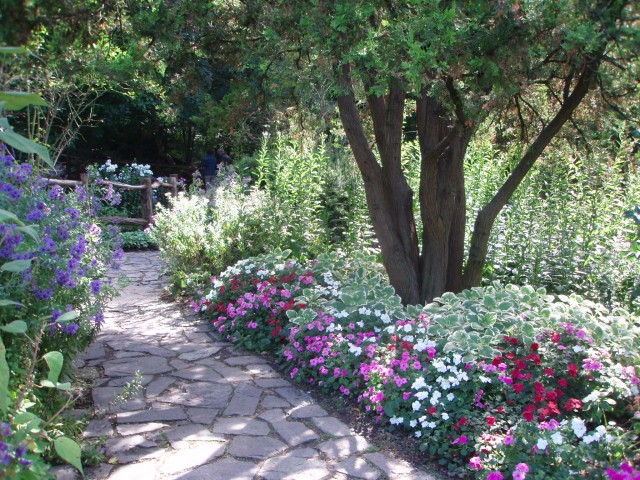
Shakespeare Garden is a four-acre landscape is named for the famed English poet and playwright. The garden is features flowers and plants mentioned in his poems and plays, with small bronze plaques scattered throughout the garden with quotes from the Bard.
The garden was first conceived in the 1880s when park commissioner George Clausen asked the Park’s entomologist to create a garden adjacent to the nature study center in the Swedish Cottage. In 1913, Commissioner Gaynor dedicated it officially to the works of Shakespeare. After years of neglect, Shakespeare Garden, just as most of Central Park, fell into disrepair. In 1987, Central Park Conservancy restored and expanded the garden, repaving pathways and installing rustic wooden benches and bronze plaques with quotations from the Bard’s masterpiece.
| internal | gDoc TBC |
| internal | Wikipedia |
| internal | Central Park Conservancy |

The first cast-iron bridge in the Park (and the second oldest in America), the bridge is named for its graceful shape, reminiscent of the bow of an archer or violinist. This handsomely designed cast-iron bridge spans the Lake, linking Cherry Hill with the woodland of the Ramble When the Park was first planned, the commissioners requested a suspension bridge. The designers compromised with this refined, low-lying bridge.
Today, Bow Bridge is one of New York’s most romantic settings and a muse for photographers. Rising from the bridge are eight cast-iron urns, installed by Central Park Conservancy in 2008 as replicas of the originals that had disappeared by the early 1920s. A skilled team of Conservancy craftsmen used historic images and took cues from an urn thought to be an exact model of those that originally adorned the Bridge.
| internal | gDoc TBC |
| internal | Central Park Conservancy |
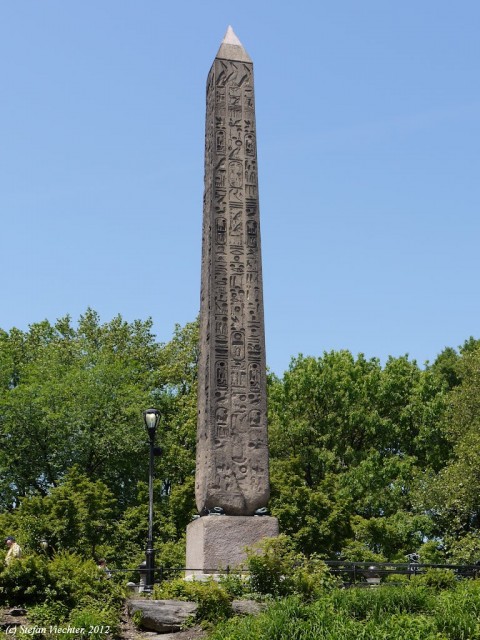
The Obelisk, nicknamed Cleopatra’s Needle, is the oldest man-made object in Central Park, and the oldest outdoor monument in New York City.
It is one of a pair of obelisks that were commissioned for Heliopolis on the banks of the Nile in 1450 BC by an Egyptian pharaoh who wished to celebrate his 30 years of reign. The monuments were then moved to Alexandria in 18AD. They remained there until one obelisk was moved to London in 1878. The second one, erected two years later in Central Park, was offered by the Egyptian Khedive to America in exchange for funds to modernize his country.
Transferring the 69-foot, 220-ton granite monument from Egypt to New York was an arduous and delicate process. It took 112 days from the time the Obelisk touched upon the banks of the Hudson River until it reached the Park. Laborers inched the monument on parallel beams, aided by roll boxes and a pile-driver engine. Thousands turned out on January 22, 1881 to marvel as the obelisk was turned upright.
A time capsule was buried beneath the Obelisk and included an 1870 U.S. census, the Bible, Webster’s Dictionary, the complete works of Shakespeare, a guide to Egypt, and a facsimile of the Declaration of Independence. A small box was placed in the capsule by the man who orchestrated the purchase and transportation of the Obelisk. He will probably be the only person in history ever to know its contents.
In 1989, the Central Park Conservancy restored the Obelisk’s terrace and landscape with new illumination, benches, and paving. From 2013 through 2014, The Conservancy completed a comprehensive project to clean and conserve the monument. Although the primary purpose was to enable further study of the monument and promote its long-term preservation, cleaning the monument had the most dramatic outcome, revealing its granite surface and hieroglyphs that had been obscured by decades of dirt and pollution.
The Obelisk landscape is particularly beautiful in spring when the monument is surrounded by flowering magnolias and crabapple trees.
| internal | gDoc TBC |
| internal | Wikipedia |
| internal | Central Park info |
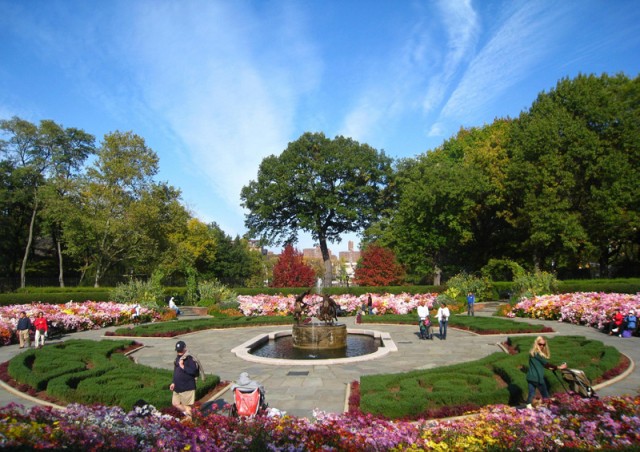
The Conservatory Garden is Central Park’s six-acre formal garden. It is divided into three smaller gardens, each with a distinct style: Italian, French, and English. The Garden’s main entrance is through the Vanderbilt Gate, on Fifth Avenue between 104th and 105th Streets. This magnificent iron gate, made in Paris in 1894, originally stood before the Vanderbilt mansion at Fifth Avenue and 58th Street.
The Italianate center garden is composed of a large lawn surrounded by yew hedges and is bordered by two exquisite allées of spring-blooming pink and white crabapple trees. A 12-foot high jet fountain plays on the western end of the lawn, backed by tiered hedges and stairs that lead up to a wisteria pergola. On the walkway under the pergola are medallions inscribed with the names of the original 13 states.
The northern, French-style garden showcases parterres of germander and spectacular seasonal displays of spring tulips, and Korean chrysanthemums in autumn, all within an ellipse of Japanese holly. In the center is the charming Three Dancing Maidens fountain by German sculptor, Walter Schott. To the south is the very intimate English-style garden. There are five mixed borders of trees, shrubs and perennial plants, and five seasonal beds featuring spring bulbs that are followed by annual flower displays. A slope of woodland plants lines the western edge of this garden. At the center is sculptor Bessie Potter Vonnoh’s lovely Frances Hodgeson Burnett Memorial Fountain, a tribute to the author of the children’s book, The Secret Garden. The children — a girl and a boy, said to depict Mary and Dickon, the main characters from the classic — stand at one end of a small water lily pool.
The Conservatory Garden is an officially designated Quiet Zone and offers a calm and colorful setting for a leisurely stroll, and intimate wedding, or an escape with a good book.
For many years the garden was tended by volunteers from the Garden Club of America and in 1983 it was restored by the Central Park Conservancy.
| internal | gDoc TBC |
| internal | Wikipedia |
| internal | Central Park Conservancy |

Bethesda Terrace Arcade was created in the 1860s as a part of the Park’s main architectural feature. A grand staircase connects the Mall to the subterranean arcade.
It was conceived to be an ornate interior that would act as a distinct counterpart to the open terrace and Lake. The highlight of the arcade is the magnificent Minton Tile ceiling designed by British-born architect and designer, Jacob Wrey Mould, who also conceived of the decorative carvings throughout the Terrace.
Installed in 1869, there are more than 15,000 colorful, patterned encaustic tiles, made by England’s famed Minton Tile Company. Encaustic tiles, originally created to cover floors, are made of individual colored clays pressed and fired into the tile to form the design. Bethesda arcade is the only place in the world where these Minton tiles are used for a ceiling. The niches that flank the walls of the arcade are covered with trompe l’oeil paintings that resemble the colored stone inlay design that was never completed. Over the decades, the 50-ton ceiling deteriorated. In the 1980s, the tiles were placed in storage. Thanks to charitable donation, Central Park Conservancy was finally able to restore the ceiling and the arcade in 2000.
| internal | gDoc TBC |
| internal | Ceiling is Believing |
| internal | Central Park Conservancy |
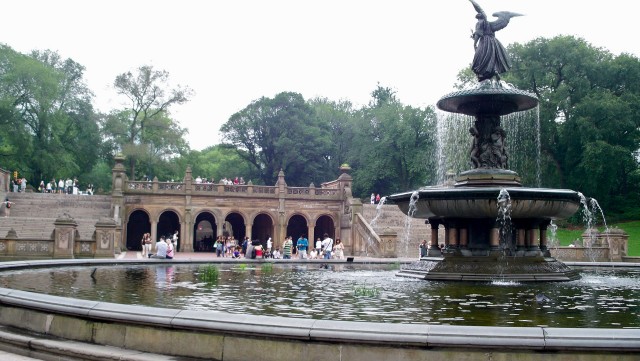
Rising from Bethesda Terrace is Bethesda Fountain, with the famous Angel of the Waters statue atop. The statue references the Gospel of John, which describes an angel blessing the Pool of Bethesda and giving it healing powers. The fountain commemorates the Croton water system, which first brought fresh water to New York City in 1842. The angel carries a lily in her left hand — a symbol of the water’s purity, very important to a city that had previously suffered from a devastating cholera epidemic before the system was established. The piece is the only statue that was commissioned for the Park. Created by Emma Stebbins, it also marked the first time a woman received a public art commission in New York City.
| internal | gDoc TBC |
| internal | Wikipedia |
| internal | Central Park Conservancy |
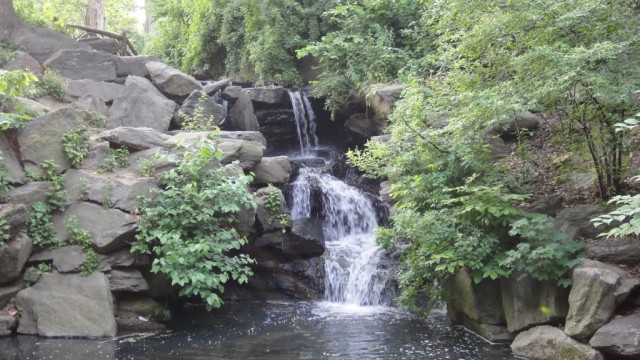
Winding through the Ravine, the Loch, Scottish for “lake,” is partially fed by a natural watercourse, known in the 17th and 18th centuries as Montayne’s Rivulet. It flows under Glen Span and Huddlestone arches before connecting to the Meer. The stream, designed by Frederick Law Olmsted and Calvert Vaux, is dammed in several places to create three magnificent cascades, some of the greatest features of engineering and art.
| internal | gDoc TBC |
| article | The Central Park Loch; Taming a Wilderness to Hew to Olmsted's Concept |
| internal | Central Park Conservancy |
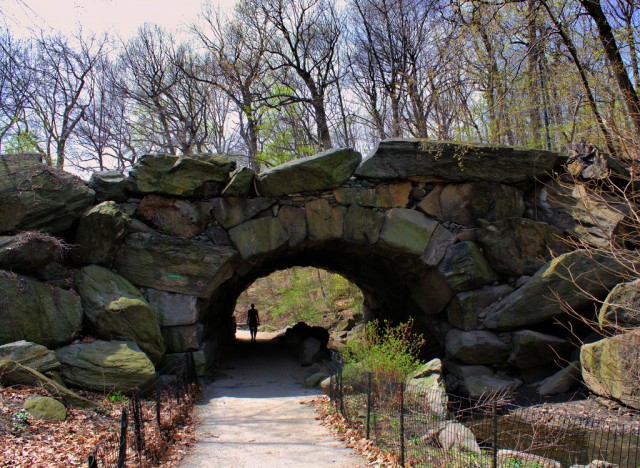
A marvel of engineering and construction, Huddlestone Arch is considered by many to be the most surprising of Central Park’s arches. Built entirely of huge, uncut boulders, the 1866 arch, design Calvert Vaux is constructed without the use of mortar or other binding material. Only gravity and pressure keep the massive boulders in place, one of which is said to weigh 100 tons. The arch actually supports traffic over the Loch to the East Drive.
| internal | gDoc TBC |
| sight | Central Park Conservancy |
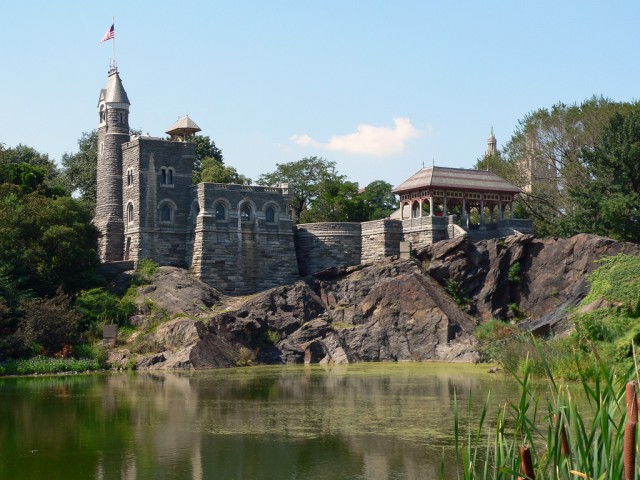
Calvert Vaux, co-designer of Central Park, created the miniature castle in 1869 as one of its many whimsical structures intended as a lookout to the reservoir to the north (now the Great Lawn) and the Ramble to the south. Belvedere provides the best and highest views of the Park and its cityscape. It’s fitting, considering its name translates to “beautiful view” in Italian.
“Right now, the temperature in Central Park is…” Since 1919, the National Weather Service has taken measurements of New York’s weather from the castle’s tower with the aid of scientific instruments that measure wind speed and direction. In a fenced-in compound just south of the castle, other data such as the rainfall is recorded and sent to the weather service’s forecast office at Brookhaven National Library on Long Island. After decades of deterioration, Central Park Conservancy renovated and reopened the castle in 1983 as a visitor center.
| sight | Huddlestone Arch |
| internal | gDoc TBC |
| internal | Wikipedia |
| internal | Central Park Conservancy |
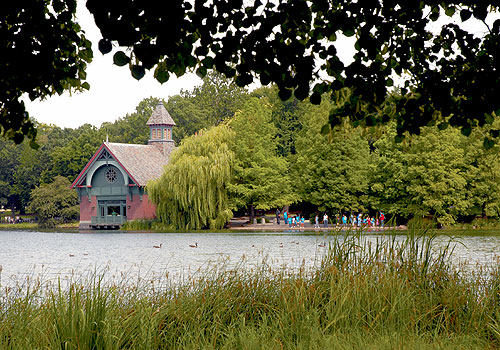
Central Park designers Olmsted and Vaux named this man-made water body “the Meer” — Dutch for “lake.” It memorialized the former separate village of Harlem that was settled in the 17th Century by European settlers and included the upper regions of Central Park.
Today, families flock to this area for catch-and-release fishing, skating and swimming at Lasker Rink and Pool, and exploration at two nearby playgrounds. The Harlem Meer is also a thriving wildlife habitat and home to fish, turtles, and waterfowl. Several varieties of trees, including oak, bald cypress, beech and gingko, surround it.
On the northern shore of the Meer stands the Charles A. Dana Discovery Center, a visitor center run by the Central Park Conservancy. The Center hosts free community programs, exhibits, and holiday celebrations including the popular Halloween Pumpkin Sail and winter Holiday Lighting. There’s also live music on the plaza in the summer at the Harlem Meer Performance Festival.
| internal | gDoc TBC |
| internal | Wikipedia |
| internal | Central Park Conservancy |
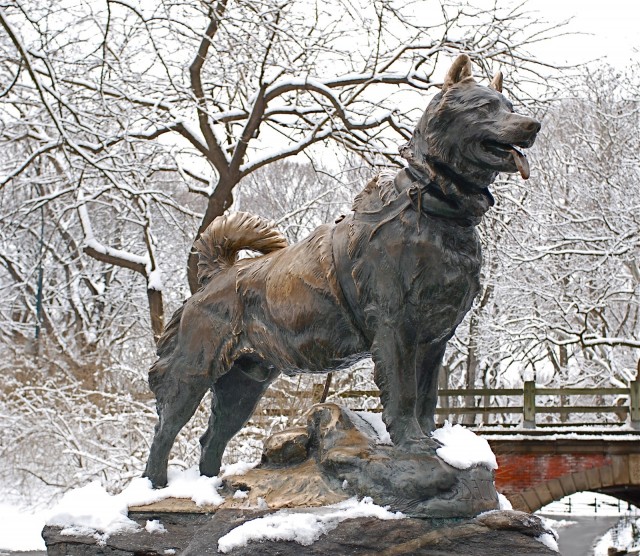
This sculpture honors the sled dog who saved Alaska’s children from a diphtheria epidemic by delivering medicine over the frozen tundra. In January 1925, Alaskan doctors feared a deadly diphtheria epidemic would spread among the children of Nome. Medicine to stop the outbreak existed, but doctors needed to travel nearly a thousand miles to Anchorage to retrieve it. More than 20 sled teams coordinated to make the trip through blinding snow and sub-zero temperatures. Led by Balto, the team covered 53 treacherous miles back to Nome in 20 hours. Newspapers and radio around the world followed the trek, fascinated by the brave team whose efforts eventually helped end the epidemic.
Balto became a national hero. Just 10 months after the successful mission, this statue by animal sculptor Frederick G. R. Roth was dedicated in Central Park.
| internal | gDoc TBC |
| internal | Wikipedia |
| internal | Central Park Conservancy |
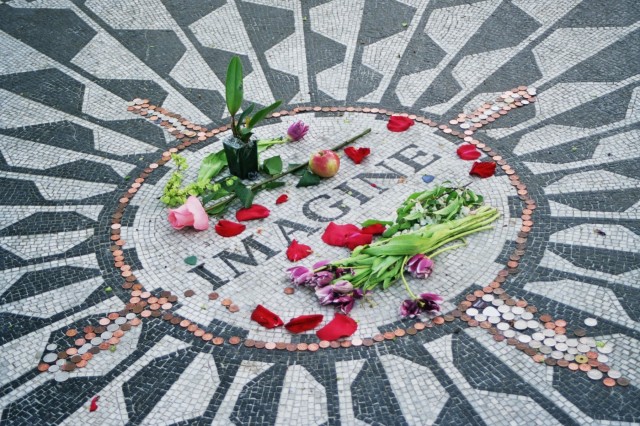
Strawberry Fields is a living memorial to the world-famous singer, songwriter and peace activist, John Lennon. During his career with the Beatles and in his solo work, Lennon’s music gave hope and inspiration for world peace and his memory and mission lives on in Strawberry Fields.
This tranquil section of Central Park was named after one of Lennon’s favorite songs, “Strawberry Fields Forever.” Recorded in 1966, the song’s title comes from an orphanage in Liverpool, England where Lennon used to go to play with the children. His aunt, who raised him, disapproved but he insisted it was, “nothing to get hung about.” Hence, the song’s famous lyric.
Strawberry Fields was officially dedicated on October 9, 1985, the 45th anniversary of Lennon’s birth. Lennon’s widow, Yoko Ono Lennon, worked with landscape architect Bruce Kelly and Central Park Conservancy to create a meditative spot. The black-and-white mosaic was created by Italian craftsmen and given as a gift by the city of Naples. Based on a Greco-Roman design, it bears the word of another of Lennon’s songs: Imagine. A designated Quiet Zone in the Park, the memorial is shaded by stately American elms and lined with benches. In the warmer months, flowers bloom all around the area. Along the path near the mosaic, you’ll find a bronze plaque that lists the 121 countries that endorse Strawberry Fields as a Garden of Peace.
| internal | gDoc TBC |
| internal | Wikipedia |
| internal | Central Park Conservancy |
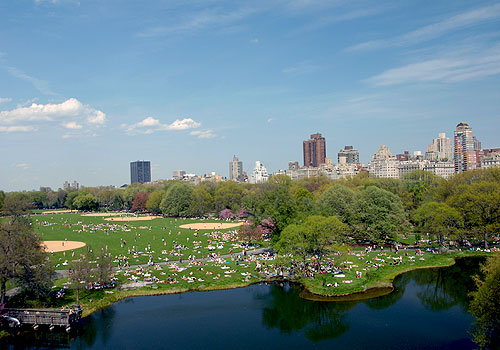
This green 55-acre area is the geographical center of Central Park, and one of the most famous lawns in the world.
The Great Lawn was originally the site of the rectangular Croton Reservoir. When Frederick Law Olmsted and Calvert Vaux were designing Central Park, they disliked the reservoir’s rectangular shape, a contrast to their vision for a curvilinear, naturalistic landscape. The designers compensated by using dense plantings to camouflage the site from park visitors. The reservoir was drained in 1931 and filled with excavation material from Rockefeller Center and the Eighth Avenue subway.
A flurry of site proposals followed. Suggestions included a World War I soldiers memorial, airport landing pads, a sports arena, an opera house, underground parking garages, and even a vault to store motion pictures. Olmsted and Vaux’s vision of a rural retreat ultimately prevailed. The oval lawn opened in 1937, with baseball diamonds added in the 1950s.
Through the years, the Great Lawn played host to memorable performances by Simon and Garfunkel, Diana Ross, Bon Jovi, the Metropolitan Opera, and the New York Philharmonic. Unfortunately, such large gatherings and unregulated use through the 1960s and 70s left the oval a “Great Dust Bowl.” In 1997, Central Park Conservancy completed a major two-year restoration of the Great Lawn to its original splendor.
| internal | gDoc TBC |
| internal | Wikipedia |
| internal | Central Park Conservancy |
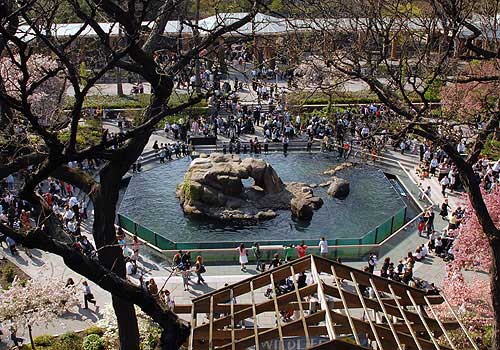
Central Park’s new, state-of-the-art Zoo was built when the Wildlife Conservation Society took over the management in 1984. It showcases animals from tropical, temperate, and polar zones around the world. Restrooms are available with admission fee.
A favorite with many visitors is the sea lion pool in the center courtyard. Its new design features glass sides so that viewers can watch these sleek carnivorous mammals gliding and spiraling under water. During feeding time (11:30 am, 2:00 pm, and 4:00 pm) the four sea lions perform simple tricks for their meal. Equally fine is the lush perennial garden surrounding the pool, with benches tucked into corners. Of course, the nearby penguins and the backstroking polar bear are perennial attractions.
Visitors can see vestiges of the old Zoo preserved in the new. Limestone reliefs by Frederick G. R. Roth of antelopes, birds, monkeys, lions, and wolves from the old animal houses have been incorporated into the new buildings.
The newest addition is the Tisch Children’s Zoo. Probably the most popular with the stroller set are the domestic animal areas around the perimeter. Here children can get close to goats, sheep, a cow and a Vietnamese pot-bellied pig. A quarter in one of the dispensers will buy a handful of nutritious food for the animals to nibble out of your hand. Small bronze sculptures of the animals stand next to each pen. When a child touches a sculpture it emits the appropriate cry or squawk. Also in the area are models of giant turtle shells, fish heads, and rabbit ears that demonstrate the mechanisms of sight, sound and body structure.
In the center of the Children’s Zoo is the Enchanted Forest. Artisans mimicked the colossal remains of primeval oak trees, acorns, and a giant spider. In the central aviary — actually a complete habitat — you will see live turtles and frogs along with birds. You’ll also find one of the two children’s theaters there. The other theater is in the central courtyard. A troupe of actors at the Acorn Theater in the Tisch Children’s Zoo performs daily shows. Past shows include Eat Bugs and Metamorphosis Boogie.
Between the main Zoo and the Children’s Zoo is the George Delacorte Musical Clock, which is built on a triple archway of brick. On the north side of the arches are Frederick G. R. Roth’s Honey Bear and Dancing Goat bronze sculptures dating from 1935. From 8:00 am to 5:00 pm on the hour and half-hour, one of 44 tunes plays while a bear with tambourine, a hippopotamus with violin, a goat with pan pipes, a kangaroo and offspring with horns and a penguin with drum glide around the base of the clock. In addition, on the hour two monkeys on the top of the clock appear to strike a bell.
From about March 21 through June 21, the nursery rhymes are replaced by spring melodies such as April Showers, Easter Parade,Younger Than Springtime, April in Paris and It Might as Well be Spring. For the winter holiday season, from just after Thanksgiving to the second week in January, visitors can listen to such favorites as Winter Wonderland, Jingle Bells, Deck the Halls and Joy to the World.
| internal | gDoc TBC |
| link | Central Park Zoo website |
| internal | Wikipedia |
| internal | Central Park Conservancy |
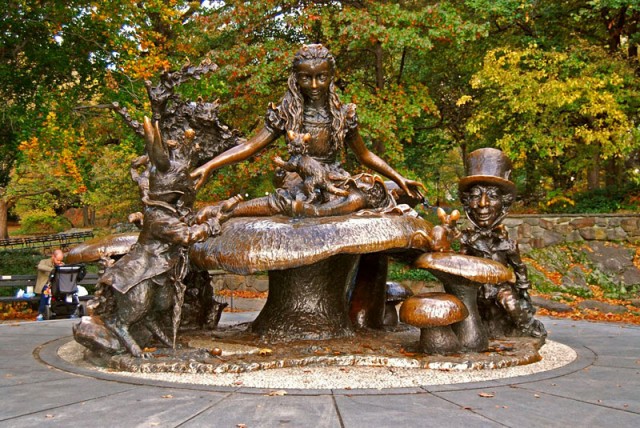
Alice and her cast of storybook friends found their way to Central Park in 1959, when philanthropist George Delacorte commissioned this bronze statue as a gift to the children of New York City. Inspired by the zany characters of the Lewis Carroll classic Alice’s Adventures in Wonderland, the sculpture was also meant as a tribute to his late wife, Margarita, who read Alice to their children. Engraved around the statue are lines from his nonsensical poem, The Jabberwocky.
The sculpture is a favorite among children, who love to climb atop it and explore its varied textures and hiding spaces. Through the years, thousands of tiny hands have literally polished parts of its patina surface smooth.
Created by the Spanish-born American sculptor José de Creeft, the piece depicts Alice holding court from her perch on the mushroom. The host of the story’s tea party is the Mad Hatter, a caricature of George Delacorte. The White Rabbit is depicted holding his pocket watch, and a timid dormouse nibbles a treat at Alice’s feet.
This sculpture is for children and meant to be climbed on.
| internal | gDoc TBC |
| internal | Alice in Wonderland Statue |
| internal | Central Park Conservancy |